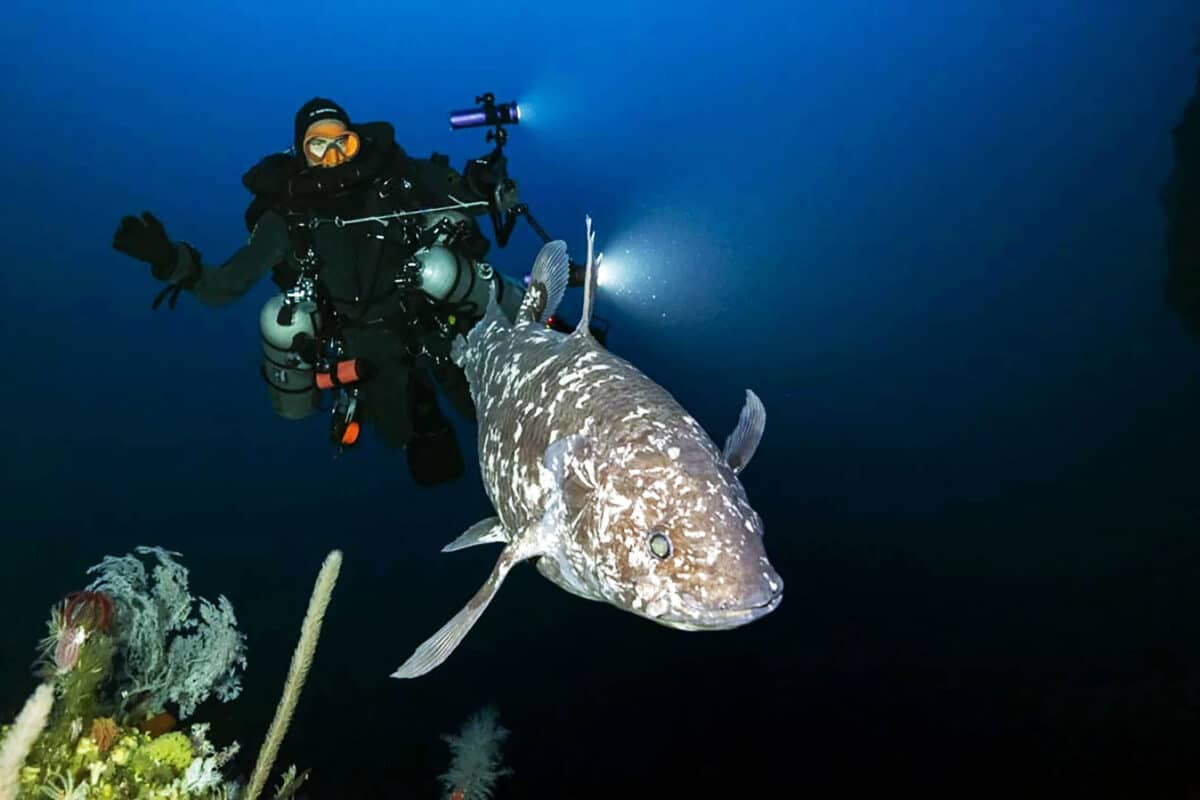In October 2024, deep-technical divers off the coast of North Maluku, Indonesia, recorded the first-ever underwater images of a live Sulawesi coelacanth (Latimeria menadoensis). Long considered a relic of the past—and for decades presumed extinct—this prehistoric fish was filmed gently hovering 144 meters beneath the surface, suspended over a slope strewn with volcanic rock and deep-reef corals.
The documentation, published in Scientific Reports, marks the first human-filmed encounter of a coelacanth in its natural habitat. It is also the first confirmed record of L. menadoensis in the Maluku archipelago, extending the known range of a species already classified as Vulnerable on the IUCN Red List.
Underwater Footage Confirms Elusive Species’ Survival
The coelacanth belongs to the Sarcopterygii, or lobe-finned fishes, a clade that includes the evolutionary ancestors of all land-dwelling vertebrates. These animals date back over 400 million years, with fossil evidence placing them well before the age of dinosaurs. Until a specimen was pulled from the Indian Ocean in 1938, coelacanths were believed to have gone extinct at the end of the Cretaceous period, over 70 million years ago.
Two extant species have since been identified: the African coelacanth (Latimeria chalumnae) and its Indonesian counterpart, L. menadoensis, which was formally described in 1999 after a specimen was discovered in a fish market in Manado, northern Sulawesi.
 Deep diver about a meter behind the Sulawesi Coelacanth (Latimeria menadoensis) discovered at a depth of -144 m in North Maluku, Indonesia. Credit: Alexis Chappuis
Deep diver about a meter behind the Sulawesi Coelacanth (Latimeria menadoensis) discovered at a depth of -144 m in North Maluku, Indonesia. Credit: Alexis Chappuis
Prior to this new field documentation, L. menadoensis had only been observed using Remotely Operated Vehicles (ROVs) or submersibles, with sightings limited to Sulawesi and West Papua. The Maluku observation now fills a critical geographic gap and suggests a wider distribution than previously understood.
The divers, Alexis Chappuis and Julien Leblond, conducted a series of deep technical dives using closed-circuit rebreathers and trimix gas mixtures. During their second descent, they encountered the coelacanth at 144 meters, noting water temperatures between 19–20°C and visibility exceeding 30 meters.
“We’ve seen shapes on sonar, vague silhouettes from ROVs,” said Chappuis. “But to look it in the eye, to hover just meters from it—that’s different. That’s history alive.”
The fish was estimated to be approximately 1.1 meters in total length, with its first dorsal fin fully erect during both encounters—behavior researchers believe may indicate an alert or active state. Notably, the animal was in open water, not in a cave or overhang, contradicting the long-held assumption that coelacanths are strictly crevice-dwelling during daylight hours.
Long Life, Slow Biology, Fragile Future
According to the open-access marine database FishBase, L. menadoensis is a deep-dwelling, non-migratory species, typically found at depths ranging from 150 to 200 meters. It exhibits one of the slowest life histories of any known vertebrate: individuals mature around age 40, and gestation is estimated to last nearly five years.
This combination of traits—low fecundity, late maturity, and slow metabolism—makes the species especially vulnerable to environmental disturbance. The IUCN Red List assessment warns that L. menadoensis faces threats from bycatch, habitat degradation, and pollution, and that its population is both small and severely fragmented.
 Latimeria menadoensis. © Mark Erdmann/RedList
Latimeria menadoensis. © Mark Erdmann/RedList
The mesophotic reef environments that coelacanths inhabit are increasingly affected by industrial trawling, plastic waste, and potential deep-sea mining. Moreover, researchers caution that viral interest in the footage could prompt unsupervised dive tourism, potentially disturbing critical habitats and exposing sensitive populations to unknown stressors.
Conservation Action and Data Still Lacking
Because the encounter occurred in a previously undocumented area, the researchers chose to withhold the exact coordinates of the dive site. Follow-up expeditions are now being planned to collect environmental DNA (eDNA) samples using non-invasive methods. These efforts aim to determine whether the Maluku specimen belongs to a larger metapopulation or constitutes a distinct genetic lineage.
The Indonesian Ministry of Marine Affairs is reportedly reviewing the data to inform potential deep-reef conservation strategies, including expanded Marine Protected Areas (MPAs) and updated fishing regulations. To date, however, there are no formal protections in place specifically targeting L. menadoensis in this region.
While the discovery has generated enthusiasm within the marine science community, experts involved in the fieldwork have been careful to emphasize its broader significance. In the words of Dr. Gino Limmon, a co-author of the study published in Scientific Reports:
“Protecting this fish isn’t about nostalgia. It’s about recognizing that the deep sea still holds critical biodiversity—and some of it is hanging by a thread.”
This documented encounter does not indicate population stability. It suggests rarity, endurance, and above all, ecological fragility. A single fish, filmed twice over two days, may represent a much larger unknown population—or it may be one of only a few remaining individuals inhabiting a rapidly shifting ecosystem.

